The Science Behind Morgue Refrigeration Temperatures
When searching for information about temperature morgue refrigerator settings, here's what you need to know:
| Morgue Storage Type | Temperature Range | Preservation Duration |
|---|---|---|
| Standard Refrigerator | 2-4°C (36-39°F) | 2-3 weeks |
| Morgue Freezer | -10°C to -20°C (14°F to -4°F) | Several months |
| Forensic Freezer | Up to -50°C (-58°F) | Extended periods |
The proper temperature morgue refrigerator setting is critical for dignified end-of-life care and plays a fundamental role in modern funeral services. Maintaining the right temperature doesn't just slow decomposition—it provides families with the precious time needed to say goodbye and make arrangements while preserving the dignity of the deceased. Most standard morgue refrigerators operate between 2-4°C (36-39°F), creating an environment that significantly inhibits bacterial growth and enzymatic processes that lead to decomposition.
While refrigeration has been used for preservation throughout history, modern morgue refrigeration systems have evolved into sophisticated, precisely controlled environments. Today's units maintain not only strict temperature ranges but also optimal humidity levels (typically 80-85%) to prevent tissue drying while inhibiting mold growth. This delicate balance requires specialized equipment that far exceeds the capabilities of standard commercial refrigeration.
I'm Mortuary Cooler, and I've spent over 15 years designing and supplying temperature morgue refrigerator systems for funeral homes and medical facilities across North America, helping directors maintain optimal preservation conditions while respecting space and budget constraints.
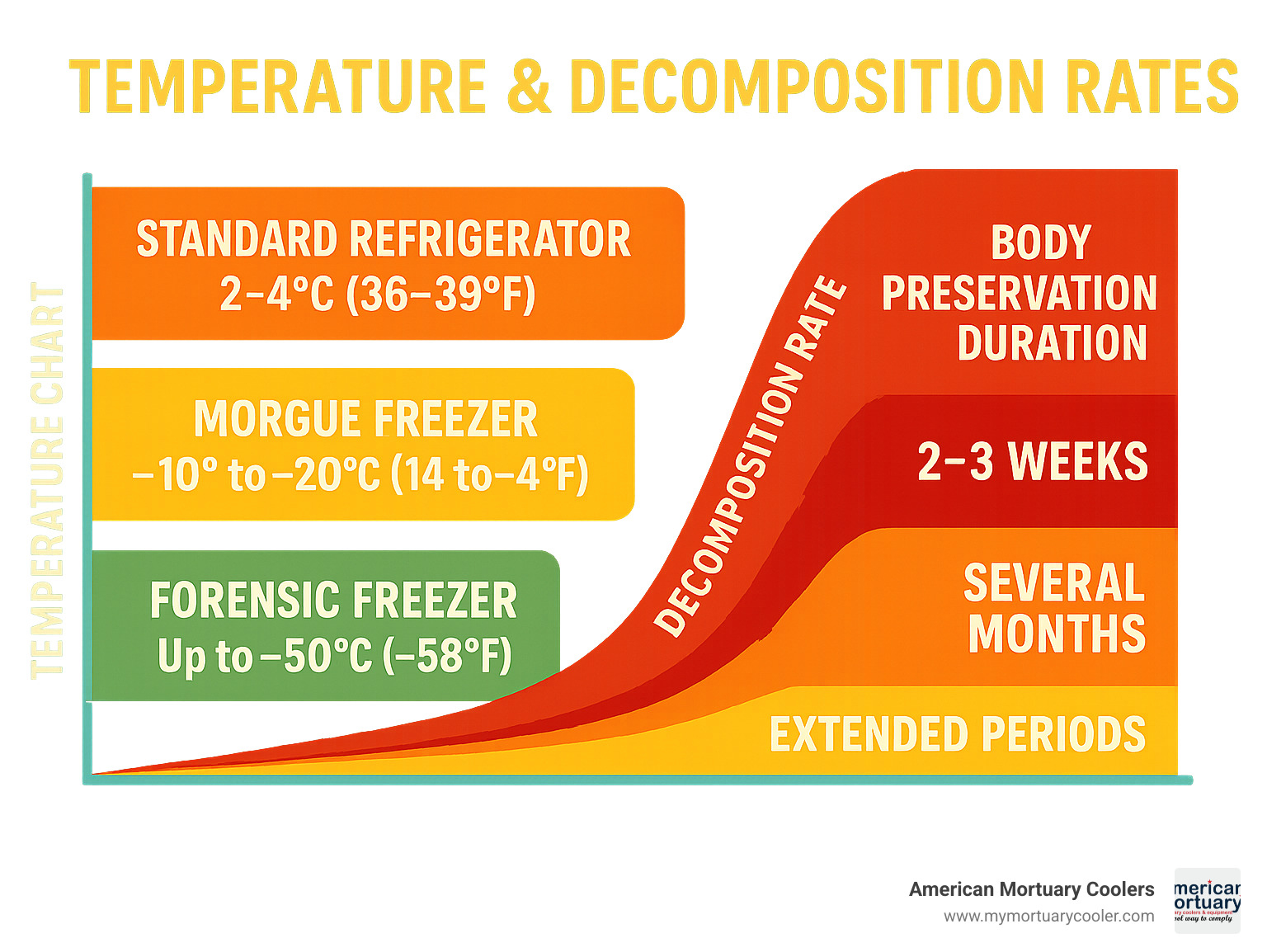
Glossary for temperature morgue refrigerator:
- do refrigerated bodies at hospital morgues smell bad
- bariatric mortuary fridge
- portable morgue refrigeration
Temperature Morgue Refrigerator Fundamentals
When it comes to temperature morgue refrigerator systems, we're really talking about two main types: positive-temperature and negative-temperature units. Each plays a unique role in preserving human remains with dignity and care.
Positive-temperature units keep things above freezing—typically between 2-4°C (36-39°F). These are your go-to systems for short-term storage when a viewing, autopsy, or embalming will happen within a few weeks. They slow decomposition without freezing tissues, which helps maintain a natural appearance.
Negative-temperature units, on the other hand, operate below freezing at temperatures from -10°C to -50°C (14°F to -58°F). These freezers essentially pause decomposition by freezing tissues, making them perfect for forensic work or when longer preservation is needed.
Both systems work on a simple principle: cooling slows molecular movement, which puts the brakes on bacterial growth and enzyme activity—the two main drivers of decomposition. As we like to say in our guide Cold Comfort: Understanding the Body Refrigerator, "Every degree matters in preservation."
How refrigeration slows decomposition
The human body begins its natural return to nature almost immediately after death through two main processes: autolysis and putrefaction.
Autolysis is essentially self-digestion—cellular enzymes start breaking down tissues from within once oxygen supply stops. Meanwhile, putrefaction occurs as bacteria (mostly from the intestines) multiply throughout the body, creating gases and fluids that cause discoloration, odor, and bloating.
A properly maintained temperature morgue refrigerator dramatically slows these processes by cooling the environment to inhibit enzyme activity (which drops by about 80% at refrigeration temperatures) and slowing bacterial growth to a crawl. The best systems also maintain humidity at 80-85%—just right to prevent tissue dehydration without encouraging mold growth.
One forensic pathologist we work with put it perfectly: "Each degree of temperature control extends our investigation window." This is why precision in refrigeration settings isn't just a technical detail—it's essential for preserving dignity in death care.

Optimal Temperature Settings for a Temperature Morgue Refrigerator
The sweet spot for temperature morgue refrigerator settings is 2-4°C (36-39°F). This range has stood the test of time in mortuary science for several compelling reasons:
It's cold enough to significantly slow decomposition without freezing tissues, which preserves the body's natural appearance for viewing. This temperature range also allows for effective embalming when needed and prevents the cellular damage that occurs during freezing and thawing.
As we explain in The Complete Guide to the Temperature of Morgue Coolers, maintaining this narrow temperature window isn't something you can achieve with standard commercial refrigeration—it requires specialized systems with precise digital controls and reliable alarms.
At American Mortuary Coolers, our units feature digital controllers that maintain temperature within ±0.5°C of your setpoint. This precision ensures optimal preservation regardless of how hot it gets outside or how often staff need to access the unit.
Power Requirements of a Temperature Morgue Refrigerator
A standard three-body temperature morgue refrigerator typically needs:
A 110V/60Hz power supply on a dedicated 20-amp circuit, with a running draw of 8-10 amps and a starting surge of 15-18 amps. For our larger walk-in units or multi-compartment systems, you'll need more robust electrical service—usually 208-230V/50-60Hz/1Ph.
Because preservation is so critical, backup power isn't just a nice-to-have—it's essential. We always recommend automatic transfer switches to backup generators, uninterruptible power supplies (UPS) for control systems, and battery backup for alarm systems.
One of our clients, a small funeral home in Georgia, shared a story that really drives this home. During a severe storm that knocked out power for three days, their investment in a backup generator system proved invaluable. Their temperature morgue refrigerator maintained perfect conditions throughout the crisis, allowing them to continue serving families without missing a beat—exactly the kind of peace of mind every funeral director deserves.
Ideal Temperature Ranges & Storage Durations
When it comes to preserving our loved ones after they've passed, temperature is everything. There's a direct relationship between how cold we keep things and how long we can maintain the dignity of the deceased.
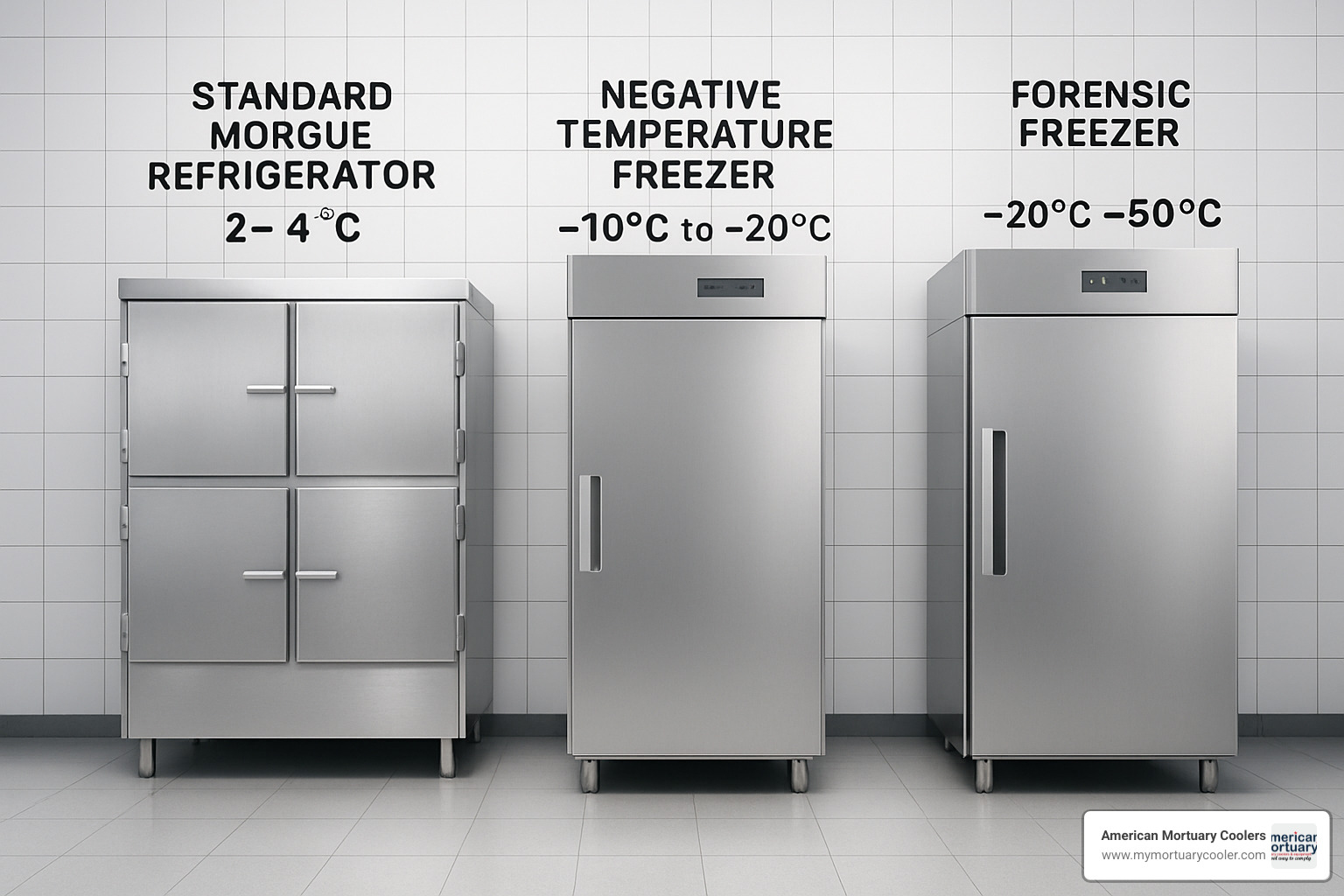
I like to think of it as a simple truth - the colder the environment, the longer we can preserve remains with respect and care. At American Mortuary Coolers, we've broken this down into a straightforward guide to help you understand your options:
| Storage Type | Temperature Range | Preservation Duration | Primary Use |
|---|---|---|---|
| Positive-Temperature Refrigerator | 2-4°C (36-39°F) | 2-3 weeks | Standard morgue storage, funeral homes |
| Negative-Temperature Freezer | -10°C to -20°C (14°F to -4°F) | Several months | Long-term storage, unclaimed remains |
| Forensic Freezer | -20°C to -50°C (-4°F to -58°F) | Extended periods (years) | Evidence preservation, research |
Short-Term (0-3 Weeks) Positive Storage
For most funeral homes and hospitals, a temperature morgue refrigerator set between 2-4°C (36-39°F) is the sweet spot. This gentle cooling preserves remains for 2-3 weeks, giving families the breathing room they need during an already difficult time.
I remember speaking with Sarah, a funeral director from Knoxville, who told me, "Those few weeks make all the difference to families. It gives them time to notify relatives overseas, coordinate with their church, and make decisions without feeling rushed." She's right - this standard temperature range supports families when they need it most.
This timeframe accommodates most of life's complications: distant relatives traveling in, coordinating with clergy who might have busy schedules, making thoughtful decisions about final arrangements, and working through any legal matters that might arise. As we explain in our Ultimate Guide to Morgue Cooler Temperature Recommendations, this temperature range also maintains natural appearance, which matters deeply for open-casket services.
Long-Term (Months) Negative Storage
Sometimes, circumstances require longer preservation. That's where negative-temperature storage comes in. Our freezer units running at -10°C to -20°C can extend preservation for months, while our specialized forensic freezers running even colder (-20°C to -50°C) can preserve remains for extended periods when necessary.
These colder units become essential in several situations. Medical examiners might need to preserve evidence during complex investigations. Sometimes families need more time for DNA testing or identification. During the height of COVID-19, many of our urban clients faced unprecedented challenges that required rapid expansion of their freezer capacity.
I'll never forget working with the medical examiner's office in Detroit during the pandemic. Within 72 hours, we had designed, built, and shipped modular freezer units to help them manage the heartbreaking surge they were experiencing. As we explore in Morgue Freezer Temperature: Keeping Cool Under Pressure, these specialized units demand more robust systems and greater energy, but provide the extended preservation capabilities that certain situations absolutely require.
While these units use more electricity, they provide peace of mind when extended preservation is needed - whether for unclaimed remains, mass-casualty events, or during pandemic situations when funeral services might face delays. The dignity of those in our care always comes first, regardless of the circumstances.
Construction, Monitoring & Compliance for Rock-Solid Temperatures
The heart of any effective temperature morgue refrigerator lies in its construction. When you're entrusting a system with the dignified preservation of human remains, every detail matters. Industry standards have evolved to require specific construction elements that ensure temperature integrity:
- 4-inch (102 mm) foamed-in-place polyurethane insulation
- Stainless steel interior surfaces for durability and ease of cleaning
- Cam-lock panel construction for airtight seals
- Vapor-tight seams to prevent condensation
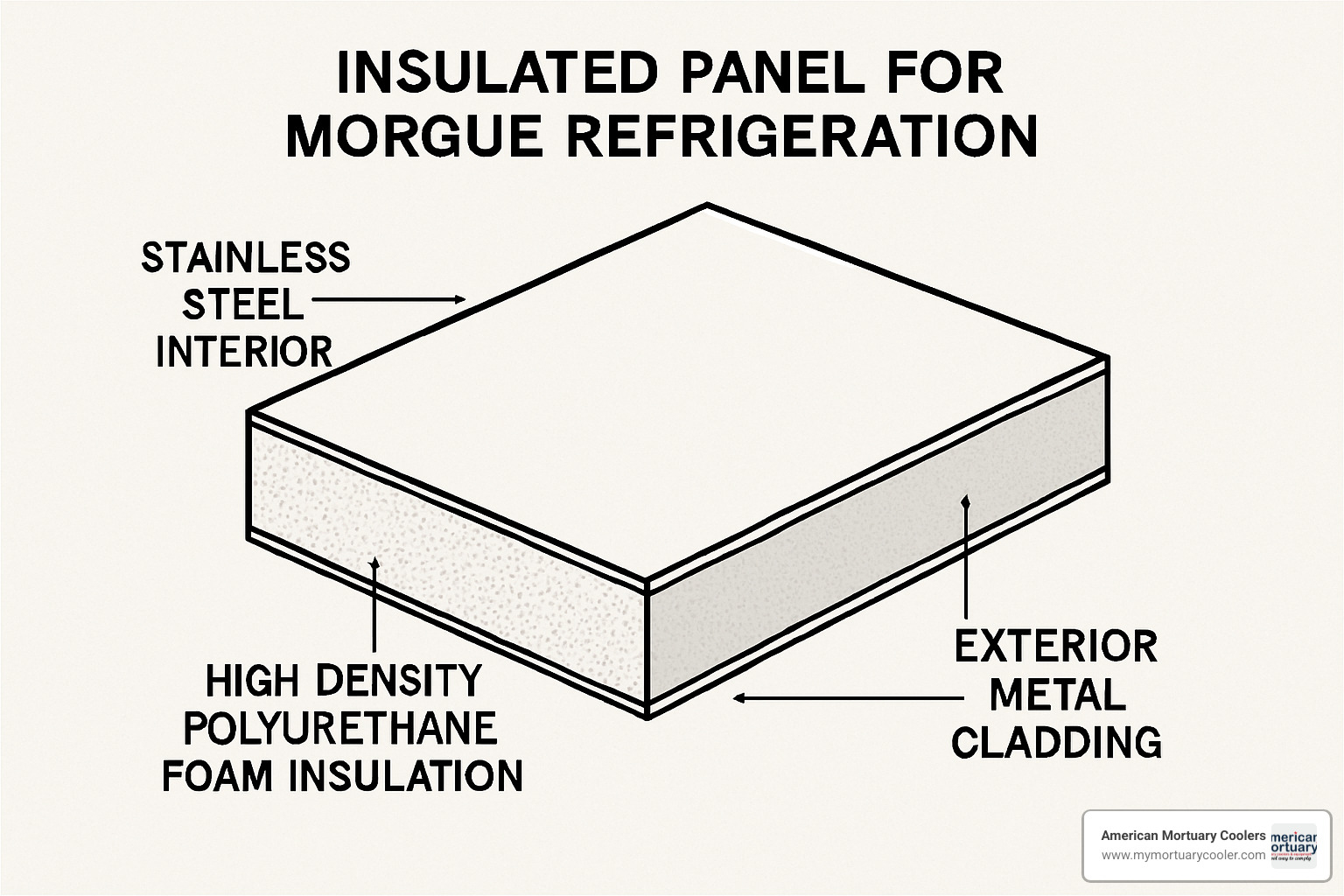
Together, these elements create a thermal envelope with an impressive R-value of approximately 32-34. This isn't just about meeting specifications – it's about creating an environment that maintains dignity through reliable temperature control while keeping energy costs manageable.
Here at American Mortuary Coolers in Tennessee, we've taken these standards to heart and pushed them further. Our premium construction features 4-inch high-density polyurethane foam with 2.2 lb/cu ft density – creating a barrier that keeps the warm world out and the cool preservation environment in. We complement this with 304 stainless steel interiors featuring a #4 finish that balances durability with cleanability, heavy-duty chrome-plated hardware that stands up to daily use, and magnetic gasket door seals that ensure an airtight closure every time.
Build Elements That Protect Internal Temperature
Think of your temperature morgue refrigerator as a carefully designed ecosystem where several elements work in harmony to maintain those critical 2-4°C temperatures.
The foundation of temperature stability starts with high R-value insulation. Our 4-inch polyurethane foam provides an R-value of approximately 8.49 per inch, creating a total R-value of nearly 34. This significantly outperforms what you'd find in standard commercial refrigeration, which typically uses just 2-3 inches of insulation. The difference becomes apparent during summer heat waves or power fluctuations.
Door gaskets and seals might seem like small details, but they're crucial guardians of internal temperature. Our magnetic gaskets combined with overlapping door designs create an airtight environment that remains secure even with frequent access – something that happens regularly in busy facilities.
One of our clients, a medical examiner in Dallas, shared a telling story after upgrading to our premium-construction temperature morgue refrigerator. They saw a remarkable 22% reduction in energy consumption while maintaining more stable internal temperatures, even during the scorching Texas summer months. This isn't just good for the budget – it's peace of mind during critical preservation periods.
Proper floor drains and condensate management systems remove moisture without creating thermal bridges that compromise temperature stability. Our energy-efficient LED lighting provides necessary illumination while generating minimal heat. And our precisely calibrated humidity control systems maintain that ideal 80-85% relative humidity zone – preventing tissue dehydration while inhibiting unwanted mold growth.
Monitoring, Alarms & Maintenance Protocols
In morgue refrigeration, what you don't know can lead to serious consequences. That's why modern temperature morgue refrigerator units feature sophisticated monitoring systems that provide both awareness and documentation.
Digital temperature displays mounted on the exterior allow staff to monitor conditions without opening doors – preserving the internal environment while providing constant visibility. High/low temperature alarms provide audio and visual alerts when temperatures stray from acceptable ranges, giving staff time to address issues before they impact preservation quality.
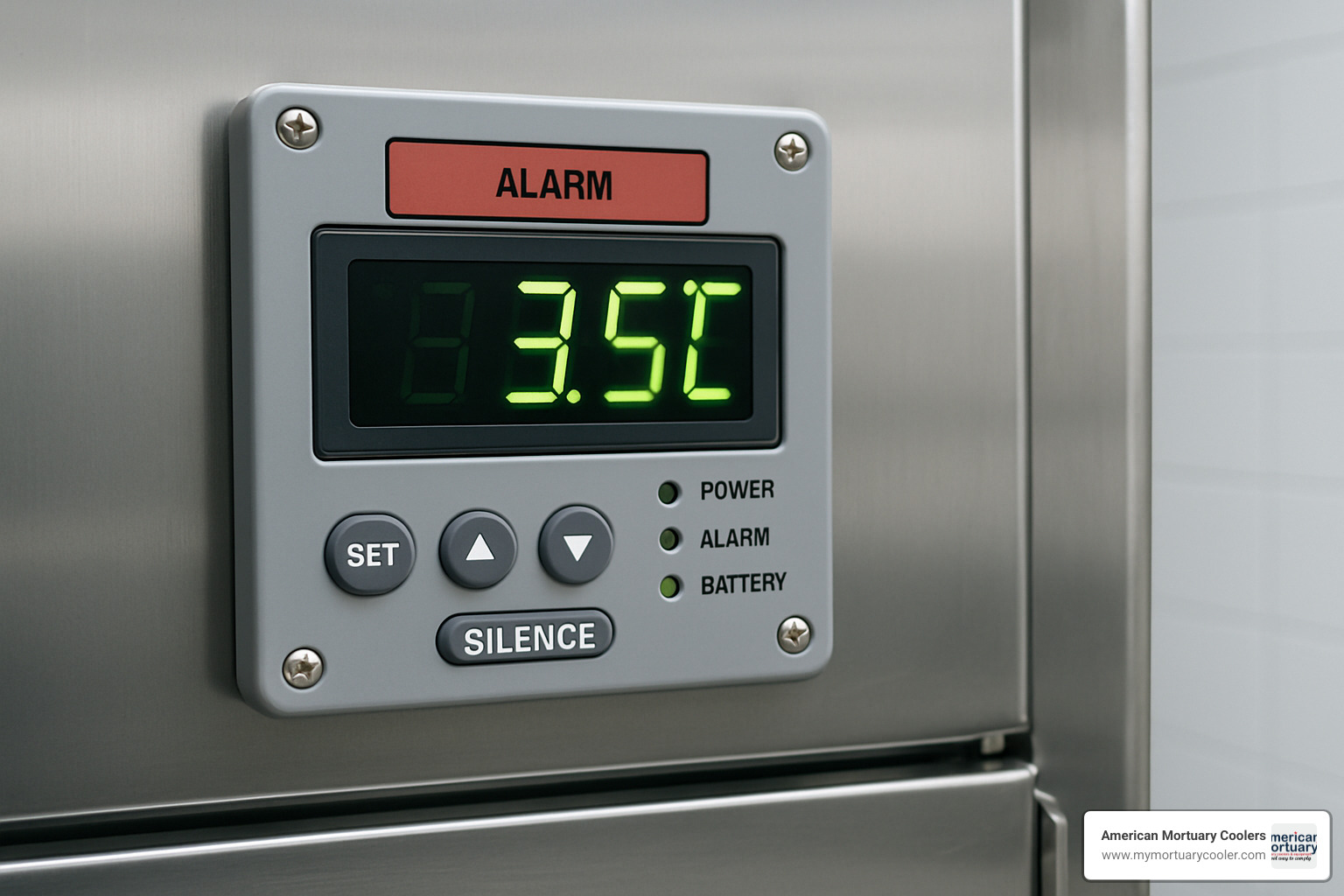
The importance of these monitoring systems was highlighted in the Latest research on capacity challenges, which documented how maintenance failures contributed to temperature control issues during periods of high demand. It's a sobering reminder that technology and human oversight must work together.
As outlined in The Complete Guide to Morgue Cooler Temperature Standards, successful temperature maintenance requires regular attention. Daily temperature checks and log entries form the foundation of any good monitoring program. Monthly cleaning of condenser coils prevents efficiency-robbing dust buildup. Quarterly inspection of door seals and gaskets catches wear before it impacts performance. Annual professional service of refrigeration systems and bi-annual calibration of temperature probes ensure accurate readings and optimal performance.
Many of our units now include remote monitoring capability, allowing network-connected systems to alert staff via text or email when temperature excursions occur – providing peace of mind even when the facility isn't staffed. Continuous data logging creates documentation for regulatory compliance and quality assurance, creating a permanent record of preservation conditions.
Regulatory & Legal Temperature Requirements
Navigating the regulatory landscape for temperature morgue refrigerator operations requires understanding several overlapping standards. While specific regulations vary by state, certain principles remain consistent across jurisdictions.
Most state health departments require morgue refrigerators to maintain temperatures between 2-4°C (36-39°F) – the scientifically established range for optimal short-term preservation. OSHA guidelines address worker safety in morgue environments, including temperature control aspects that protect both staff and the deceased. CDC recommendations include temperature standards particularly focused on infectious disease control. And for those seeking the highest standards, the College of American Pathologists (CAP) provides accreditation standards for morgue facilities that many institutions voluntarily adopt.
Documentation requirements typically include daily temperature logs that show consistent monitoring, maintenance records that demonstrate proper upkeep, calibration certificates that verify accuracy, alarm testing documentation that confirms system functionality, and staff training records that establish competency.
At American Mortuary Coolers, we understand these requirements aren't just bureaucratic hoops – they're safeguards ensuring dignity and safety. That's why we provide comprehensive documentation packages with all our units, helping clients from Columbia, SC to Chicago, IL and across our nationwide service areas meet or exceed all applicable standards. Our systems are designed not just to perform well, but to make compliance straightforward and demonstrable.
Frequently Asked Questions about Temperature Morgue Refrigerators
How long can a body remain at 2-4 °C?
When families ask me this question, I always tell them that a properly maintained temperature morgue refrigerator at 2-4°C (36-39°F) typically preserves a body for about 2-3 weeks before noticeable decomposition begins. But like many things in life, several factors come into play.
The clock starts ticking immediately after death. Bodies that reach refrigeration quickly—ideally within 4-6 hours—will preserve much better than those with delayed cooling. I've seen this difference when working with families who experienced an unexpected loss at home versus in a hospital setting.
The person's condition before death matters too. Pre-existing infections, higher body mass, or traumatic injuries can accelerate natural processes, potentially shortening our preservation window. Proper humidity control in the 80-85% range is just as important as temperature—too dry, and tissues dehydrate; too moist, and we risk mold growth.
One of our funeral directors in Atlanta shared some practical advice: "We generally encourage families to arrange unembalmbed viewing within 7-10 days, even with excellent refrigeration. After that, visible changes may become noticeable that could affect the family's experience."
Every time we open the refrigerator door, warm air enters and creates temperature fluctuations. This is why most modern facilities design their workflow to minimize access frequency—it's not just about energy efficiency, but preservation quality too.
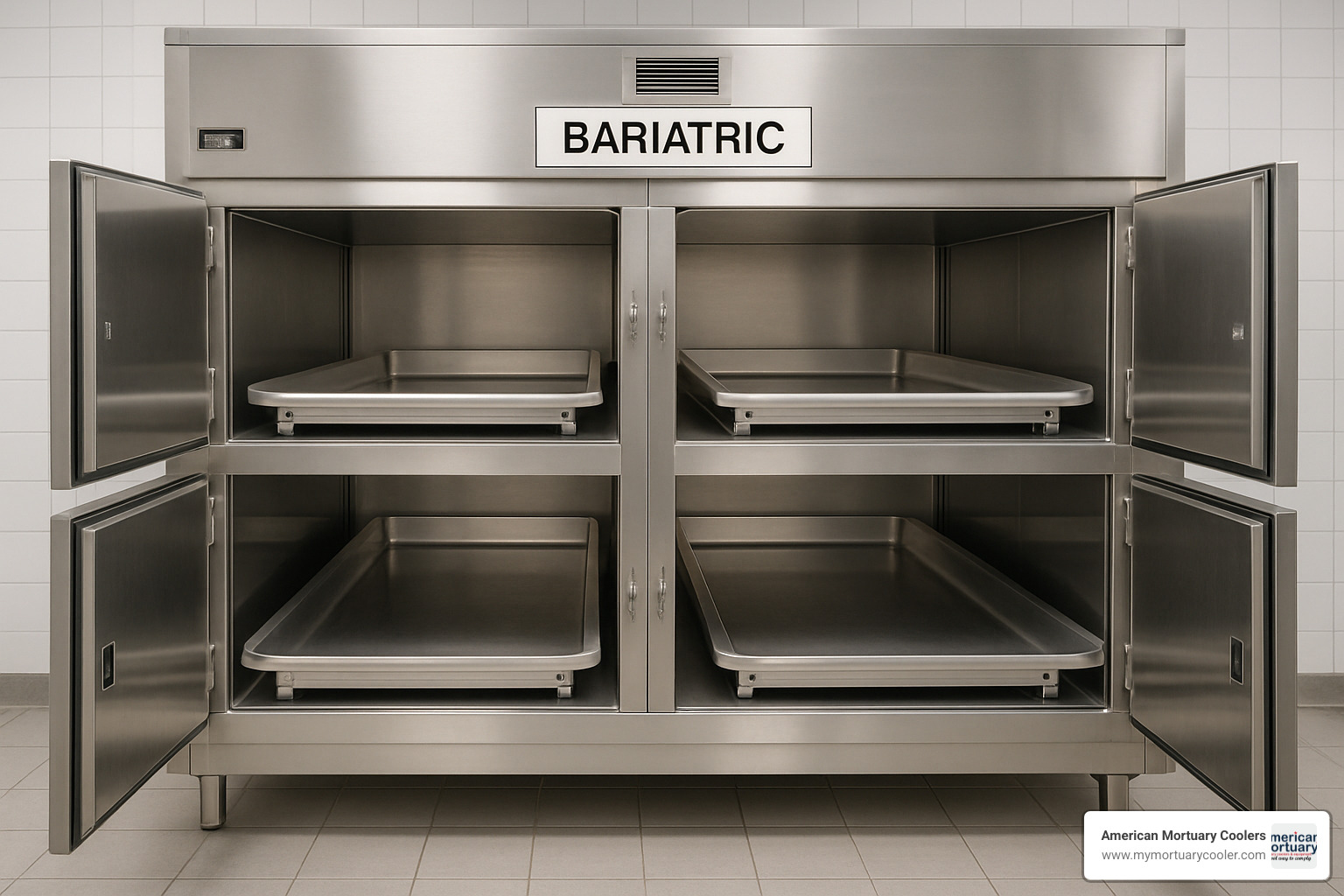
Can one temperature morgue refrigerator handle bariatric bodies?
The growing need for bariatric-capable units is something we address frequently with funeral homes across the country. Standard temperature morgue refrigerator units typically accommodate bodies up to 300-350 pounds, but today's reality requires more adaptable solutions.
Bariatric-ready refrigeration requires thoughtful engineering beyond just "making things bigger." We design these specialized units with wider trays (27"-36" compared to the standard 23"), heavy-duty telescoping rails rated for 500-1,000 pounds, and reinforced floor supports capable of handling up to 700 pounds per square foot.
Door openings need to be wider too—usually 36"-48"—to accommodate larger trays and transport equipment. And since larger bodies require more cooling power to maintain consistent internal temperatures, we install more robust refrigeration systems.
A funeral director in Dallas told me recently, "Having at least one bariatric-capable compartment isn't optional anymore—it's a necessity for serving our entire community with dignity." I couldn't agree more. At American Mortuary Coolers, we can integrate bariatric solutions into standard units or design dedicated systems based on your specific needs and space constraints.
What daily checks keep my temperature morgue refrigerator compliant?
Maintaining a temperature morgue refrigerator is a bit like caring for any precision instrument—consistent attention prevents problems before they start. Here's what I recommend to all our clients for daily checks:
Start and end each day by verifying and recording the internal temperature. That 2-4°C (36-39°F) range isn't just a suggestion—it's the scientific sweet spot for preservation. While you're at it, make sure your alarm systems are functional by performing a quick test according to your manufacturer's guidelines.
Take a moment to check that condensate is draining properly and door seals are making complete contact. A tiny gap in a gasket can cause temperature fluctuations that add stress to your cooling system (and your utility bill). A quick visual inspection of the interior for cleanliness helps maintain proper hygiene and cooling efficiency.
Listen to your compressor—it should cycle normally without unusual noises or vibrations. After years in this business, I can often diagnose issues just by listening to how a unit sounds.
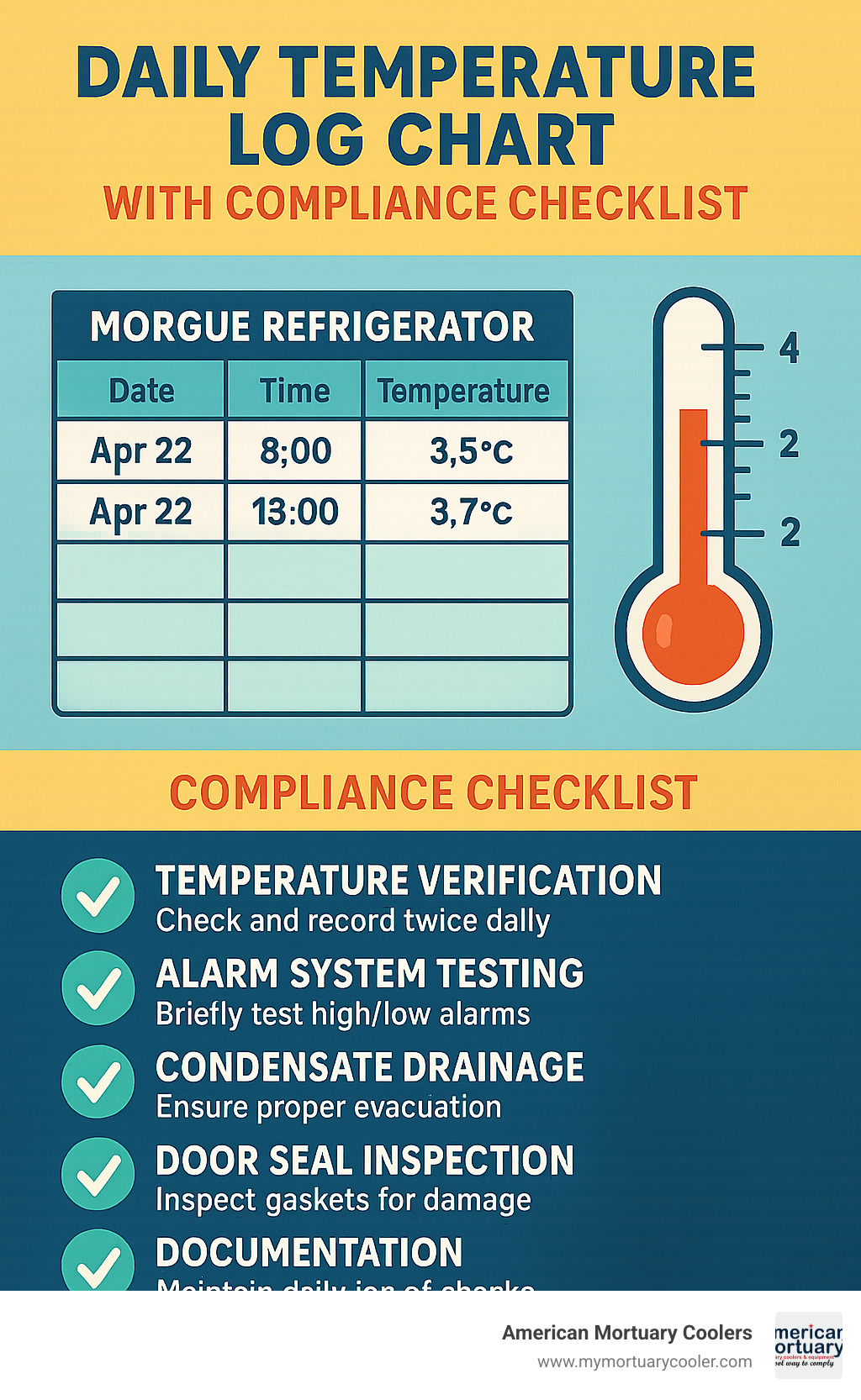
Documentation matters tremendously. I was impressed when a hospital morgue supervisor in Pittsburgh showed me their QR code-based digital logging system. "What used to take 10 minutes of paperwork now takes 30 seconds on a smartphone," they told me. "And we have better records than ever before."
These simple daily checks not only keep you compliant with regulations but also extend equipment life and ensure you're providing the respectful care families deserve. Many of our clients integrate these checks into their opening and closing procedures, making them a natural part of the workday rather than an additional task.
Conclusion
The temperature morgue refrigerator is so much more than a piece of equipment—it's a vital part of the sacred trust between families and those who care for their loved ones. When we maintain that perfect 2-4°C (36-39°F) in standard units or -10°C to -50°C for freezer systems, we're not just following protocols—we're creating the precious time and space families need to gather, grieve, and say goodbye with dignity.
Throughout our journey together in this article, we've explored the delicate science behind preservation, finded the ideal temperature ranges for different needs, and examined how thoughtful construction and vigilant monitoring keep these systems running reliably. We've tackled real questions about how long bodies can be stored, how to accommodate larger individuals with respect, and what daily checks ensure everything runs smoothly.
Here at American Mortuary Coolers, we see the human stories behind every technical specification. Each refrigeration unit we craft represents a family needing time to process their loss, a community coming together in grief, and professionals dedicated to providing care that honors the deceased. That's why we pour our hearts into building systems that blend technical excellence with compassionate design.
From our home base in Tennessee to communities across America—whether you're in the busy streets of New York NY, the warm climate of Atlanta GA, or the varied environments of Chicago IL, Columbia SC, Dallas TX, Los Angeles, or Pittsburgh PA—we're here to support funeral homes, hospitals, and medical examiners with equipment that meets their unique needs with both reliability and respect.
Thinking about upgrading your current system or wondering how to get the most from your existing equipment? We'd be honored to help. Get a custom quote from our team of caring experts who understand both the technical and human aspects of what you do.
Because in this most sensitive work of caring for those who have passed, every single degree matters—and so does every single person.
















